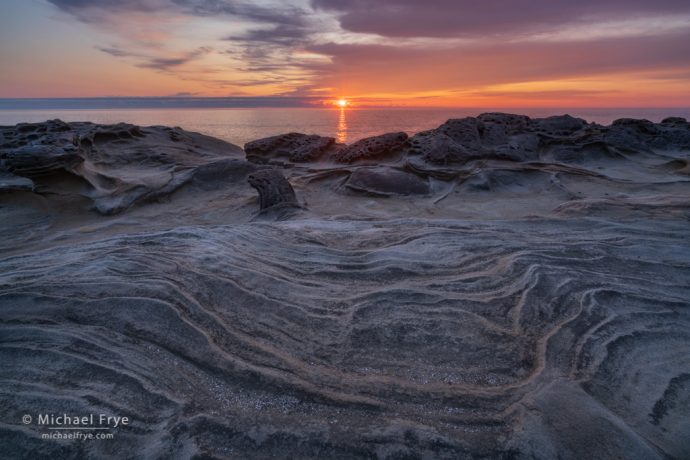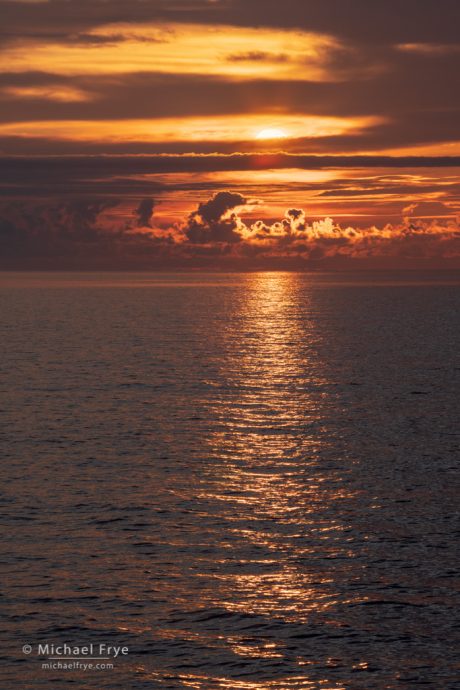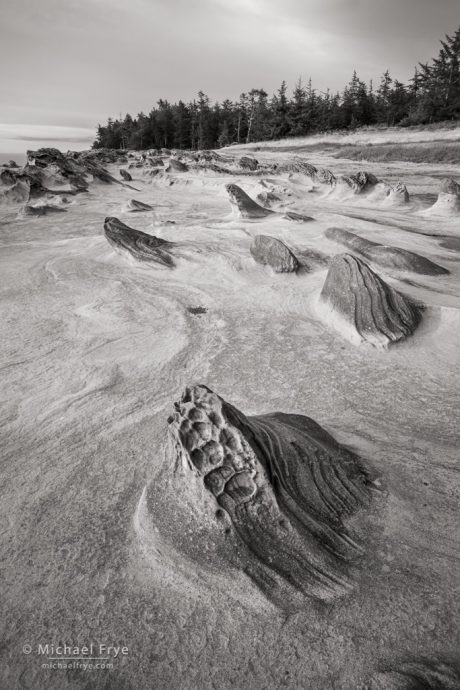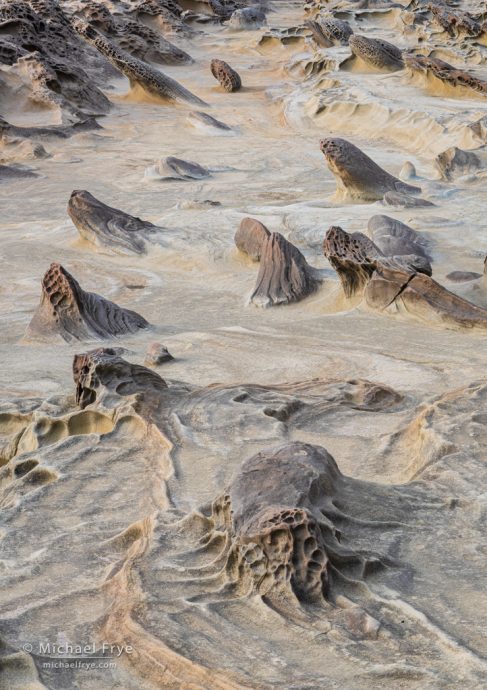
Sunset and sandstone formations, Oregon coast. 16mm, five bracketed exposures at f/16, ISO 100, blended with Lightroom’s HDR Merge, then blended back with one of the original images in Photoshop to eliminate ghosting.
Recently Claudia and I visited our friends Gary and Charlotte Gibb up near Mt. Shasta, where they were renting a house for the week. We had a great time hanging out with them for a couple of days. And then we thought, we’re so close, maybe we should visit the Oregon coast. So we did.
I’ve never spent much time along the Oregon coast, but it’s a beautiful area, and a popular photography destination for a reason, so it’s one of those places that I’ve wanted to explore more thoroughly.
Photographing an area I’m unfamiliar with always presents a challenge. Our friend G Dan Mitchell doesn’t do any research when visiting a new location, because he doesn’t want to be influenced by what other photographers have done, or haven’t done. I understand that, and I might try that approach sometime if I have plenty of time to explore. But in this case we only had a few days, and chances for good sunsets on a couple of them, so I did some online research to find interesting locations to photograph during our short visit.
On our last evening we ended up at a spot known for its unusual sandstone formations. Apparently Minor White used to take students there to practice composition, and I could see why, as the patterns and forms of the rock were striking. We got there a couple of hours before dark, so I had time to photograph just the rocks, while also keeping an eye out for interesting foregrounds in case we got a good sunset.
That last part was a challenge, because the best views of the rocks were looking north and south, parallel to the sandstone strata, rather than west toward the sunset. The foreground I liked best is the one shown at the top of this post, with the curving rock ridges framing the ocean and the setting sun. I used my widest lens (16mm), and got the tripod down low fill up most of the frame with that foreground (but not too low, or the rocks would have merged with the horizon line of the water).
Although I like that photograph, sometimes it’s better to keep things simple and stick to one subject at a time, rather than trying to juxtapose two dissimilar elements (like unusual rocks and a pretty sunset). So I also used a longer lens to capture just the ocean, sun, and clouds:

Sunset over the Pacific Ocean, Oregon coast. 200mm, two bracketed exposures (each at f/16, ISO 100) blended manually in Photoshop.
And earlier I concentrated on photographing the patterns in the rocks, as shown in the images below.
It was a quick trip, but lots of fun. I’ll post some more photographs from Oregon soon.
— Michael Frye

Sandstone formations, Oregon coast. I wanted this photograph to be about forms, patterns, and textures. The color – blue sky and golden rocks – was just a distraction, so it worked much better in black and white. 23mm, 1/8 sec. at f/16, ISO 100.

Sandstone formations, Oregon coast. This composition jumped out at me immediately, and was the first image I made at this location. I focus-stacked five frames and blended them with Helicon Focus to get everything in focus. 87mm, 1/15 sec. at f/16, ISO 100.
Related Posts: When a Scene Composes Itself; Stretching
Michael Frye is a professional photographer specializing in landscapes and nature. He is the author or principal photographer of The Photographer’s Guide to Yosemite, Yosemite Meditations, Yosemite Meditations for Women, Yosemite Meditations for Adventurers, and Digital Landscape Photography: In the Footsteps of Ansel Adams and the Great Masters. He has also written three eBooks: Light & Land: Landscapes in the Digital Darkroom, Exposure for Outdoor Photography, and Landscapes in Lightroom: The Essential Step-by-Step Guide. Michael has written numerous magazine articles on the art and technique of photography, and his images have been published in over thirty countries around the world. Michael has lived either in or near Yosemite National Park since 1983, currently residing just outside the park in Mariposa, California.









The Oregon Coast is a favorite vacationing spot. The wave action along the coast and the Haystacks are great photographic subjects.
Well it’s easy to see why you like it Larry.
I liked your photos of the Oregon coast and the sandstone formations. I have been following you for awhile and enjoy the photos and commentary. However, on this one it would be nice to know a town or city nearby. Thank you.
Thanks Charles. This is actually a pretty well-known spot, but it doesn’t seem to be overrun by photographers and Instagrammers – yet. I’d like to keep it that way, and I bet you would too. I’ve seen too many quiet, beautiful places become overrun because people post photos of it and share the location on the internet, so I no longer mention locations unless the spot is already very well-known – like, say, Tunnel View. Anyone who really wants to visit this spot on the Oregon coast can find it with a little research – that’s what I did.
Forms. Patterns. Textures. Lines. Lines. Lines. You have taught me so much about how to see design and composition. I took my time through all of my water shots from the Range of Light wrkshp and really tried to study the patterns, design, the composition. Love this series. Thanks!!!
Great set of photos, so lucky to have access to beautiful country– but then you have to be there and have vision to capture it ,which you have in abundance
Mike
Thank you Michael!